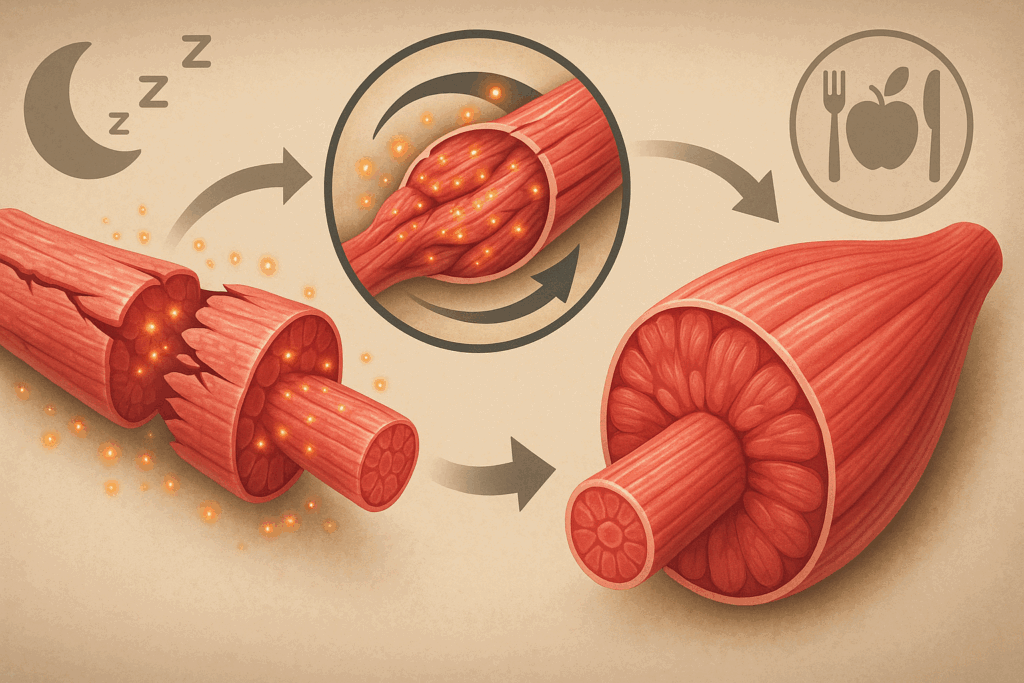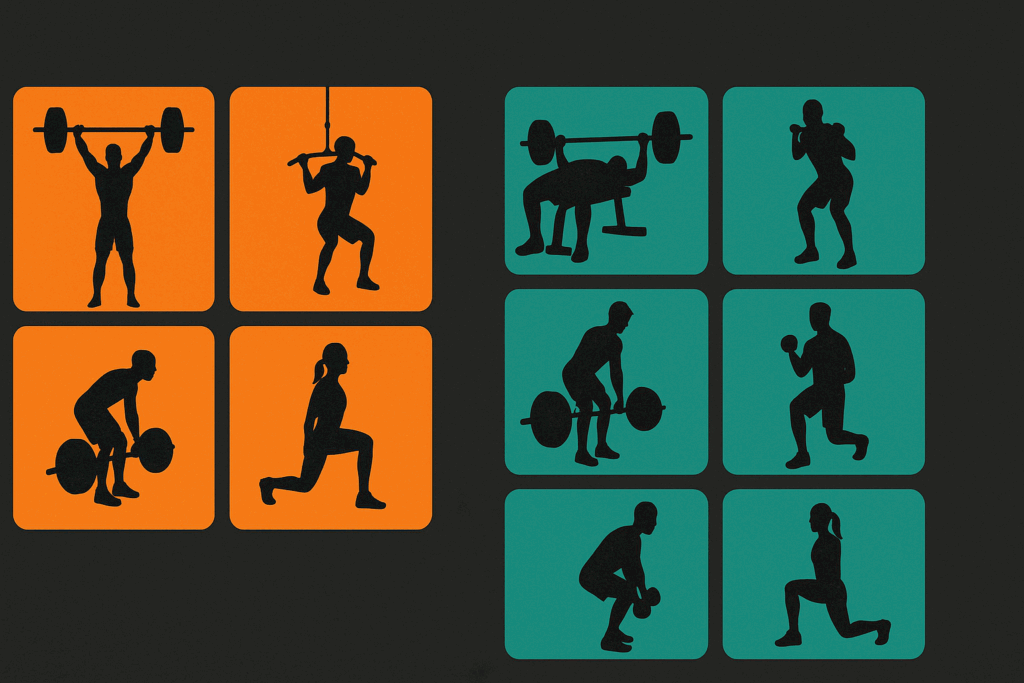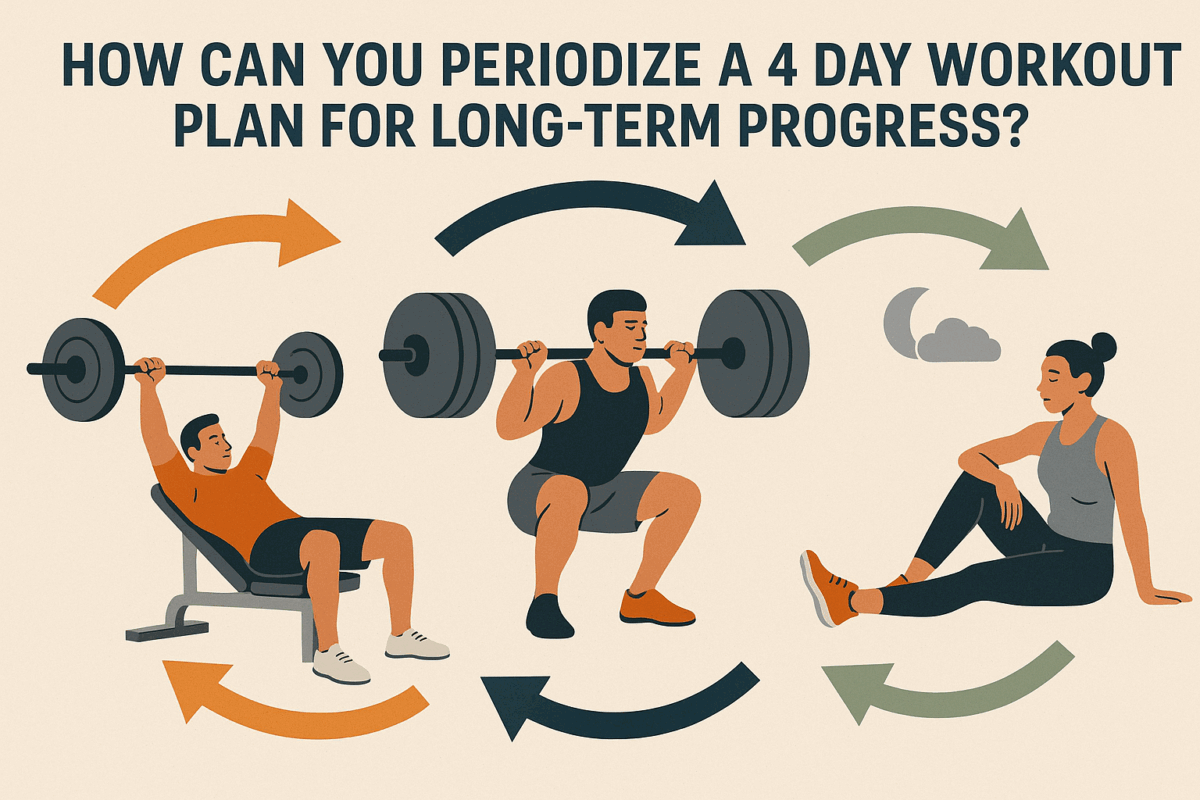Introduction
Achieving optimal muscle growth requires more than simply lifting weights. It demands a structured plan that balances training frequency, exercise selection, recovery, and progression. Among the many training approaches available, the 4 day split stands out as one of the most powerful and efficient strategies for serious muscle gains. Whether your goal is to sculpt an aesthetic physique, build strength, or simply train consistently while balancing a busy life, a 4 day workout plan offers a strategic framework that supports progressive overload, sufficient rest, and focused effort. In this comprehensive guide, we explore why this split is so effective, how to structure your training, and how to adapt it to different goals and populations.
You may also like: The Ultimate Hypertrophy Workout Program for Building Strength and Size

Why the 4 Day Split Remains a Gold Standard in Muscle Building
The 4 day workout split has earned a permanent place in the training arsenal of athletes, bodybuilders, and everyday lifters alike. One of its most compelling advantages is its flexibility. Unlike more rigid programs, a four day split allows you to schedule sessions around work, family, or academic obligations while still delivering enough frequency and intensity to support muscle hypertrophy.
Moreover, the 4 day split gym program offers a highly effective way to manage training volume. By dedicating specific days to distinct muscle groups or movement patterns, you avoid the overlap and fatigue that often plague full-body routines. This setup ensures each muscle group receives concentrated attention, allowing for a deeper stimulus and more thorough recovery. The result? Greater gains over time with reduced risk of injury or overtraining.
This format also aligns with evidence-based practices in strength training. Research supports training each muscle group at least twice per week for optimal growth. By alternating between upper/lower or push/pull configurations across four days, you can easily meet this frequency without compromising performance. Additionally, the 4 day training split is easy to personalize. You can choose your intensity, volume, and rest intervals based on your specific goals—whether that’s strength, size, or endurance.

Structuring Your 4 Day Workout Program for Maximum Hypertrophy
An effective 4 day workout program starts with intelligent structure. A popular and efficient option is the upper/lower body split, performed twice weekly. This structure balances recovery and intensity while allowing each major muscle group to be trained twice—a sweet spot for both hypertrophy and strength. For example, your week could include upper body on Monday, lower body on Tuesday, rest on Wednesday, upper body again on Thursday, and lower body again on Friday or Saturday.
For bodybuilders, a 4 day bodybuilding split might be structured more traditionally: chest and triceps on day one, back and biceps on day two, legs on day three, and shoulders plus abs on day four. This approach allows for higher volume per muscle group within each session and gives you the opportunity to train with greater focus. However, it also demands careful attention to recovery—especially for synergistic muscles that are involved across different days.
A 4 day lifting split built around push/pull dynamics is another effective method. Push days typically train the chest, shoulders, and triceps, while pull days target the back and biceps. This split is both logical and efficient, grouping muscles based on similar functions. It’s a great choice for intermediate lifters looking to increase their training volume while maintaining a high level of performance.
Regardless of the specific split, your 4 day workout routine should incorporate key principles: progressive overload, compound and isolation movements, and recovery protocols. Don’t just go through the motions—track your lifts, adjust your rep ranges, and listen to your body. Every session should move you closer to your long-term goals.

The Science Behind the 4 Day Split and Muscle Recovery
Recovery is just as vital to muscle growth as training, and the 4 day split supports recovery better than many other formats. When you train intensely, you cause microtears in muscle fibers. The body responds by repairing and strengthening those fibers—provided it has the nutrients, rest, and hormonal support to do so. The 4 day split offers regular rest intervals that facilitate this process without derailing your training frequency.
Each workout in a 4 day weight training split is intense but limited in scope, allowing for localized recovery. If you train legs on Tuesday, for instance, your upper body sessions on Monday and Thursday don’t interfere with their recovery. This makes the split particularly attractive for lifters who want to keep pushing hard without regressing due to systemic fatigue.
From a hormonal standpoint, this type of training avoids the excessive cortisol buildup seen in longer, more frequent programs. Balanced sessions over four days support a more favorable testosterone-to-cortisol ratio, which is crucial for muscle growth. Sleep quality, immune response, and even mental clarity improve with appropriate recovery—a fact often overlooked by those training six or seven days a week.
Additionally, muscle protein synthesis peaks 24–48 hours post-training. By rotating which muscles are trained each day, the 4 day split workout routine ensures you’re always capitalizing on this window, maximizing growth potential throughout the week.
How to Customize Your 4 Day Workout Plan for Specific Goals
One of the most exciting features of a 4 day workout plan is its adaptability. You can tweak your exercises, rep ranges, rest periods, and exercise order to suit virtually any fitness goal. For example, lifters aiming for hypertrophy should focus on moderate reps (8–12), shorter rest periods (30–60 seconds), and higher total volume. This approach increases muscle tension and metabolic stress—two key drivers of growth.
For strength-focused individuals, a 4 day workout program might incorporate lower reps (3–6), heavier loads, and longer rests (90–180 seconds). Compound movements like squats, deadlifts, and bench presses should form the foundation, supported by accessory lifts that correct imbalances and improve joint stability. Periodization can also play a role, alternating between phases of hypertrophy, strength, and power to keep the body adapting and progressing.
Athletes or those with performance goals can integrate plyometrics, sprint work, and dynamic movements into their sessions. For example, one upper-body day could include Olympic lift variations, while a lower-body day might include sled pushes or box jumps. These exercises improve neuromuscular efficiency, agility, and coordination, while still contributing to muscle development.
Even fat loss programs can benefit from a four day split workout. By combining resistance training with metabolic finishers—short, intense bursts of activity—you can burn fat while preserving lean mass. The key is to monitor recovery and ensure nutritional support, especially protein intake, remains high.

4 Day Workout Split for Women: Tailoring Strength and Aesthetics
The 4 day workout split female athletes follow often differs slightly in emphasis, but not in structure or effectiveness. The fundamentals of muscle physiology apply to both men and women—muscles grow in response to resistance, nutrition, and recovery. However, many women prioritize glute, leg, and core development, along with overall tone and metabolic health.
A tailored 4 day split for women might include two lower-body focused days—one heavy, one volume-based—and two upper-body days that target shoulders, back, and arms. Core exercises can be integrated as finishers or warm-ups. Movements like hip thrusts, Romanian deadlifts, lunges, and glute bridges are staples for building strength and aesthetic balance.
Hormonal differences mean women often recover faster from certain types of training and can benefit from slightly higher reps and volume. Incorporating circuits or supersets can increase training density and make sessions more time-efficient. Importantly, women should not shy away from heavy lifting—a well-designed 4 day gym program can produce lean muscle, enhance metabolism, and reshape the physique without adding bulk.
Women with specific goals—such as postpartum recovery, bone health, or improved energy—can adjust their 4 day split accordingly. Training smart, staying consistent, and enjoying the process are the foundations of success, regardless of gender.

Comparing the 4 Day Split to the 5 Day Workout Split
Many lifters find themselves choosing between a 4 day split and a 5 day training split. Both can be effective, but they cater to slightly different needs. A 5 day workout split typically dedicates one day to each major muscle group: chest, back, legs, shoulders, and arms. This can increase weekly volume and allow for more detailed isolation work. However, it also demands more time and greater recovery management.
In contrast, the 4 day split gym program is more manageable for most people. It allows for greater focus on compound lifts and more recovery time without significantly sacrificing volume. The best four day workout split often includes a balance of volume and intensity, making it ideal for steady, long-term gains.
For lifters prone to fatigue or with limited availability, the 4 day option may provide better consistency. Over time, consistency trumps perfection. The best 5 day workout split might offer theoretical advantages in volume, but if it leads to missed sessions or burnout, it becomes counterproductive.
Ultimately, the choice between a 4 day and 5 day lifting split should be based on lifestyle, recovery ability, and preference. Whichever option helps you train hard, stay consistent, and enjoy the process is the best split for muscle growth.
Frequently Asked Questions: Maximizing Results with a 4 Day Split
What Are Some Overlooked Benefits of Following a 4 Day Split?
Beyond its well-known advantages in muscle growth and recovery, the 4 day split offers several underappreciated benefits. For instance, it supports lifestyle balance by giving you three full rest or active recovery days, which can be used for mobility, sports, or mental wellness activities. This promotes long-term consistency and lowers the risk of burnout. Additionally, because each session is more focused, you can fine-tune form and technique on specific lifts without the fatigue that comes with longer, full-body sessions. Many lifters also report improved mental focus and motivation when training fewer days, as the routine feels less like a chore and more like a performance-oriented ritual.

How Can You Periodize a 4 Day Workout Plan for Long-Term Progress?
To keep making gains, you should consider periodizing your 4 day workout plan through phases of hypertrophy, strength, and recovery. Begin with a hypertrophy block lasting 4–6 weeks using moderate weights, higher reps, and shorter rest periods. Then transition into a strength phase with heavier weights and lower reps to develop raw power. After this, integrate a deload week or a lower-intensity block to allow the nervous system to recover. You can repeat this cycle throughout the year, adjusting based on feedback from your performance and recovery. This structure not only prevents stagnation but also reduces the chance of overuse injuries often seen in unchanging routines.
Can a 4 Day Workout Split Female Program Include Cardio Without Hindering Muscle Growth?
Yes, and in fact, including cardio can enhance recovery and improve overall conditioning in a 4 day workout split female program. The key is to manage the type, intensity, and timing of cardio. Low-intensity steady-state (LISS) sessions performed on rest days or after weight training can aid in circulation and muscle repair. High-intensity interval training (HIIT) should be used sparingly—perhaps once a week—to avoid interfering with strength adaptations. Choosing non-impact cardio modalities like rowing, incline walking, or cycling can protect joints while still providing cardiovascular benefits. Always ensure that your total calorie intake supports both your strength training and cardio workload to maintain lean mass.
How Does the 4 Day Split Compare to the 5 Day Workout Split in Terms of Hormonal Response?
A 4 day split can lead to more stable hormonal environments than a 5 day workout split due to better balance between training stress and recovery. Training five days a week, especially with high volume, can increase cortisol levels and lead to diminishing returns over time if not carefully managed. A 4 day a week workout split typically reduces this hormonal strain, allowing for better testosterone-to-cortisol ratios, which are crucial for anabolic processes. Furthermore, a more sustainable workload can improve sleep quality, reduce inflammation, and promote better adherence to proper nutrition. These factors cumulatively support a stronger hormonal profile over the long term.
What Is the Best Way to Transition from Full-Body Training to a 4 Day Split Workout Routine?
Transitioning from full-body training to a 4 day split workout routine requires gradual adjustment in volume and intensity. Start by reducing frequency while maintaining your previous volume, distributing it across the four new split days. This eases your body into more targeted sessions and allows muscle groups more time to recover. Make sure to keep compound lifts like squats, presses, and rows in rotation but begin incorporating more isolation movements to stimulate specific muscle fibers. Track your recovery, especially for muscle groups trained heavily in full-body workouts, to avoid overtraining. Over the course of 2–3 weeks, you’ll adapt to the new structure, and your performance should improve as fatigue levels stabilize.
How Can You Use a 4 Day Bodybuilding Split to Improve Symmetry and Weak Points?
A 4 day bodybuilding split is an excellent platform for improving physique symmetry and correcting imbalances. You can prioritize lagging muscle groups by scheduling them earlier in the week when you’re most fresh, or even hit them twice using different rep ranges. For example, if your rear delts or hamstrings lag, you could include them in both your push/pull or upper/lower days with complementary exercises. Advanced techniques such as supersets, drop sets, and tempo manipulation are particularly effective in this context. Regularly filming your workouts and performing visual assessments can also help identify imbalances that aren’t always noticeable in daily training.
What Are Effective Recovery Strategies Between Sessions in a 4 Day Training Split?
Maximizing recovery between sessions in a 4 day training split involves more than just rest. Prioritize quality sleep—aim for at least seven hours nightly—as this is when growth hormone levels peak. Stay hydrated and consume balanced meals rich in protein, carbs, and healthy fats to replenish glycogen and repair muscle tissue. Active recovery techniques such as foam rolling, light cardio, or yoga can enhance circulation and reduce soreness. It’s also important to monitor your stress levels since psychological strain can impair physical recovery. Supplementing with magnesium, omega-3s, or adaptogens like ashwagandha may further support nervous system restoration when used appropriately.
What Makes the Best 4 Day Workout Split for Intermediate Lifters?
The best 4 day workout split for intermediate lifters emphasizes progressive overload, movement variety, and strategic recovery. At this stage, lifters often benefit from alternating between heavy and volume days to stimulate both muscle fiber types. For instance, heavy squats and deadlifts could be programmed on one lower-body day, with higher-rep leg presses and lunges on the other. Similarly, an upper-body push day might feature low-rep bench presses, while a secondary day includes incline dumbbell work and flyes for more time under tension. Intermediate lifters should also begin integrating accessory work based on weak-point identification and periodizing rest intervals to match specific goals within the 4 day gym program.
What Role Does Exercise Order Play in the Effectiveness of a 4 Day Exercise Plan?
Exercise order is a crucial variable in the success of a 4 day exercise plan. Starting with compound, multi-joint movements such as squats or bench presses ensures you’re using your freshest energy reserves for the most taxing lifts. This allows for greater load capacity and neural drive, translating into more effective strength and muscle gains. Following with isolation movements helps target specific muscles once the primary movers are fatigued. Strategic ordering also reduces the risk of injury, particularly if stabilizing muscles are recruited before heavier lifts. Periodically reversing order—starting with isolation work—can be used as a shock method to break through plateaus or induce metabolic stress for hypertrophy.
How Can Women Maximize Results on a 4 Day Full Body Workout Plan?
While traditional 4 day full body workout plans are more common in beginner or minimalist routines, women can modify them for advanced aesthetic and functional results. One strategy is to rotate emphasis within each session: focus on the posterior chain in one workout and anterior in the next, while still hitting all major muscle groups. Additionally, alternating movement patterns—like a hinge-dominant lift followed by a squat-dominant one—can enhance neuromuscular balance. Incorporating unilateral exercises such as single-leg deadlifts or dumbbell presses helps develop coordination and address side-to-side discrepancies. Women can also benefit from varying tempos to challenge muscle control and increase time under tension, which is particularly effective for shaping glutes and shoulders within a balanced 4 day workout routine.
Conclusion: Making the 4 Day Split Your Long-Term Strength Strategy
When it comes to building lasting strength, muscular development, and training consistency, the 4 day split delivers on all fronts. It combines the principles of exercise science with real-world practicality, offering a path to meaningful gains without the burnout or rigidity of more demanding programs. Whether you’re just getting started or refining an advanced training regimen, a 4 day workout routine provides the flexibility, intensity, and recovery needed for long-term success.
By structuring your training smartly—whether through an upper/lower, push/pull, or bodybuilding format—you can customize your journey toward strength and aesthetics. The 4 day split workout routine respects your time, your recovery, and your goals. It empowers you to train with purpose, recover fully, and grow stronger week after week.
As you build your 4 day workout program, remember: the key is not just to train harder, but to train smarter. Pay attention to progression, embrace variety, and prioritize recovery. With consistency, discipline, and the right mindset, the 4 day split can become your most powerful tool for building a resilient, muscular, and high-performing body.
Further Reading:
The Best Workout Splits For Every Goal





